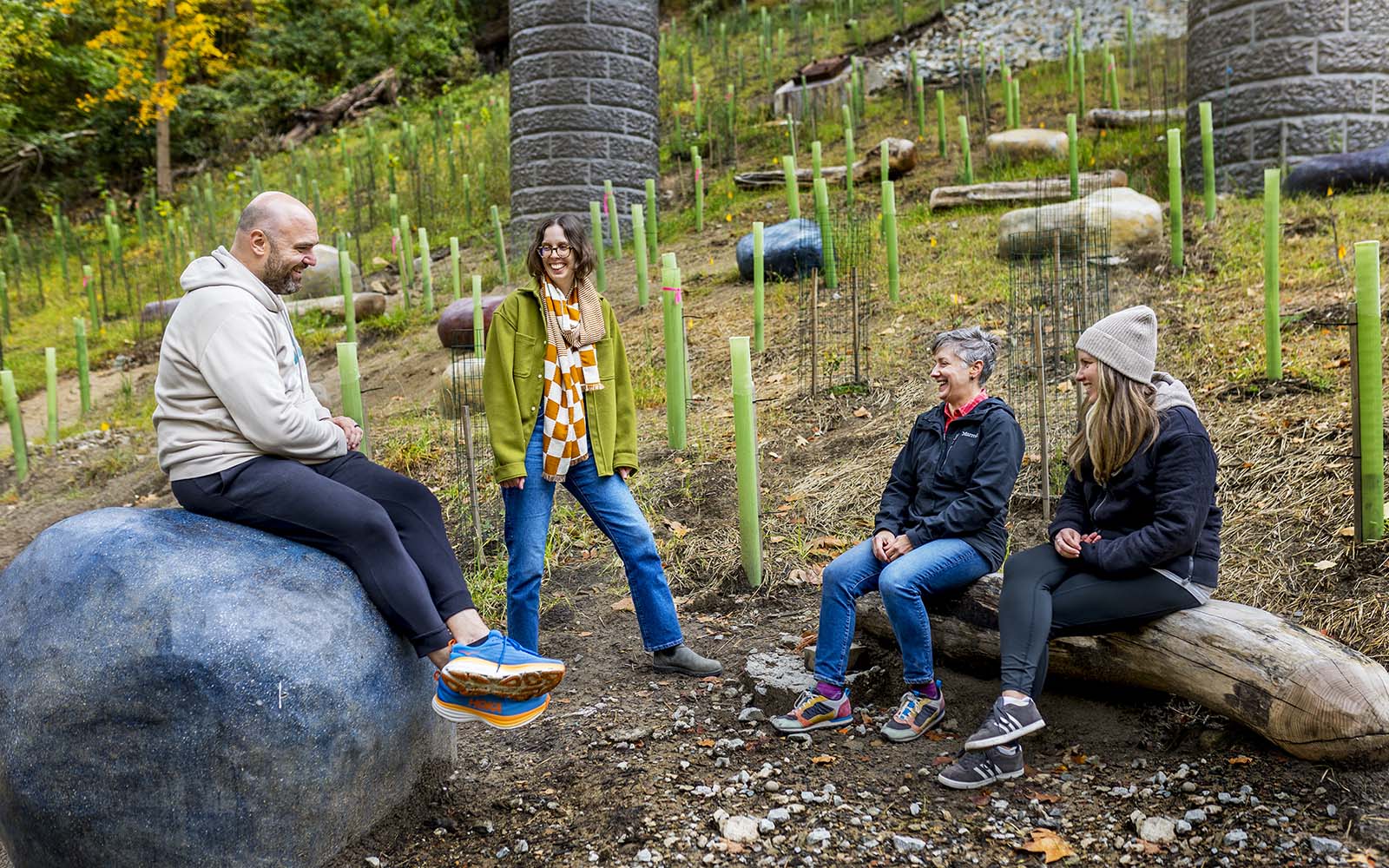
Artist Carin Mincemoyer, shown here second from the right, is seated amidst her 2023 installation Trail Meander. Located under the new Fern Hollow Bridge, the artwork welcomes trail goers to dwell in the space and be attuned to their surroundings. Photo by Sean Carroll.
Art. Works.
Shifting Expectations for What is Possible
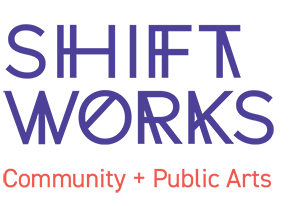
This week we are excited to share how one organization supports artists, communities, and organizations through public arts. Shiftworks Community + Public Arts, formerly known as the Office for Public Art (OPA), recently reorganized as an independent nonprofit, and while their name has changed, their mission has not.
Sallyann Kluz, executive director of Shiftworks, and Ashley Anderson, marketing and communications manager of Shiftworks, reflect on how the organization collaboratively shapes public space through the arts—aiming to shift not only landscapes and cityscapes, but also expectations and perspectives for what is possible.
By Sallyann Kluz and Ashley Anderson, Guest Contributors
It’s time for a pop quiz! Which of the following is a public art project?
- Artist-designed postcards, illustrating works by Black artists in the city of Pittsburgh;
- A play that reflects the oral histories of Afghan refugee women who have settled in southwestern Pennsylvania;
- A visual history of the waters of what we now call Fern Hollow etched on the infrastructure of a newly constructed bridge;
- A residency program to support Black artists who m/other;
- An artist-led meditation on the Explorer riverboat, accompanied by investigations of the microscopic organisms living in the waters of Pittsburgh’s three rivers;
- All of the above
If you answered all of the above, you likely view public art as something that extends beyond what many see as its traditional definition—a mural, mosaic, sculpture, or monument in public space. You understand public art as the way artists and their creative practices can help shift our perceptions and expectations of shared spaces and stories. You experience public art as not only the product of the work of artists, but also as the process through which they engage community members to create the work.
Shiftworks Community + Public Arts works to broaden the understanding of what public art is or can be. We view public art as inclusive of the practice of engaging artists to collaboratively shape public spaces and experiences—physically, socially, and culturally. We believe that the process of creating the artwork is just as valuable as the final artwork. In fact, the process of creating the work may actually be the artwork.
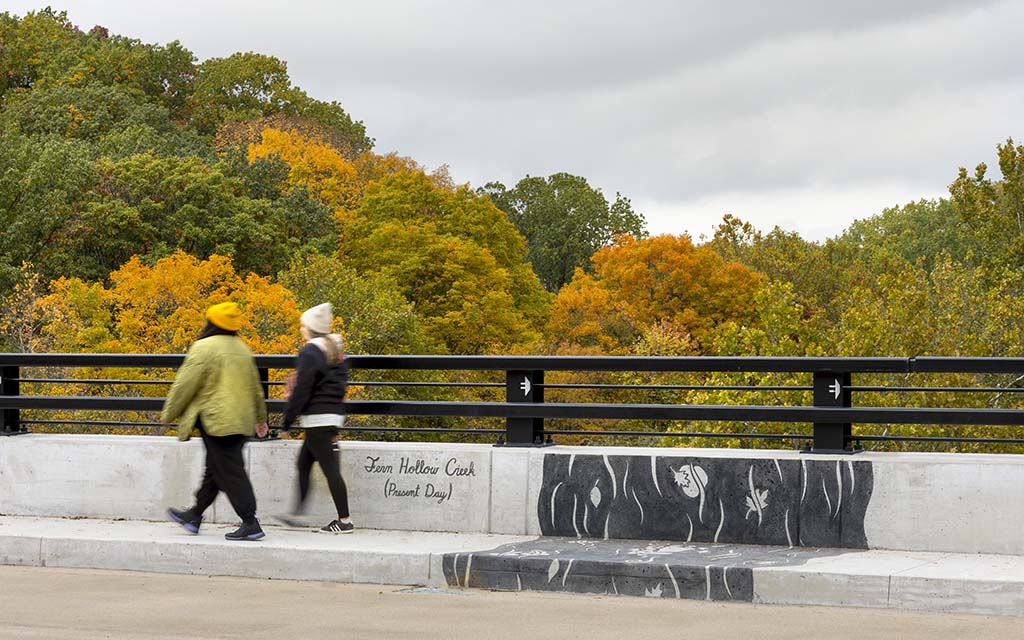
400 Million Years of Water is an artwork on the new Fern Hollow Bridge by artist John Peña, 2023. Photo by Sean Carroll.
Who is Shiftworks?
Shiftworks Community + Public Arts, formerly the Office for Public Art (OPA), is a Pittsburgh-based nonprofit organization working across southwestern Pennsylvania to collaboratively shape public spaces and catalyze community-led change. Established in 2005 as a one-person part-time office to advance the role of public art in the region, we have grown to a team of seven full-time staff that is stewarding public art projects across southwestern Pennsylvania. Our team has worked behind the scenes on numerous public art projects for nearly 20 years. In that time, we have supported the creation of more than 70 temporary artworks, 30 permanent installations, and 20 artist residencies, in addition to creating 325 events celebrating the work of artists in public space throughout the region.
As our capacity has grown, so has our ability to be more actively engaged in a broader spectrum of public art projects. In our early years, we focused on building the knowledge of what public art existed in the region and facilitating others to commission new artworks. Over time, we have greatly expanded our work to increase support for both artists and communities interested in working in public space. We do this through a range of projects that:
- Support artists seeking to connect their studio practices to public space;
- Commission artists as part of design teams for infrastructure and other large-scale projects;
- Facilitate social and civically engaged works that bring community members and artists together as cocreators.
Through it all, we are guided by the following four key principles that we strive to engage in all aspects of the organization.
Artists are agents of social, civic, and cultural change.
Yes, public art can physically enhance public places, making neighborhoods and shared spaces more beautiful. And yes, public art can be revitalizing and entertaining, and bring economic opportunities. But the process of developing public art projects can also provide unique pathways and engage communities in critical conversations about their visions, hopes, and aspirations.
Artists working in public space can create platforms that amplify the voices and talents of community members who have been disenfranchised, overlooked, or ignored in civic processes.
In this, public art can be a catalyst for community change, advancing social, civic, and cultural goals. Engaging artists opens up opportunities for creative problem-solving and encourages new kinds of interactions among participants. Through public art projects and programs, communities become more deeply engaged in shaping the future of our region, and become more connected, resilient, and innovative through the process.
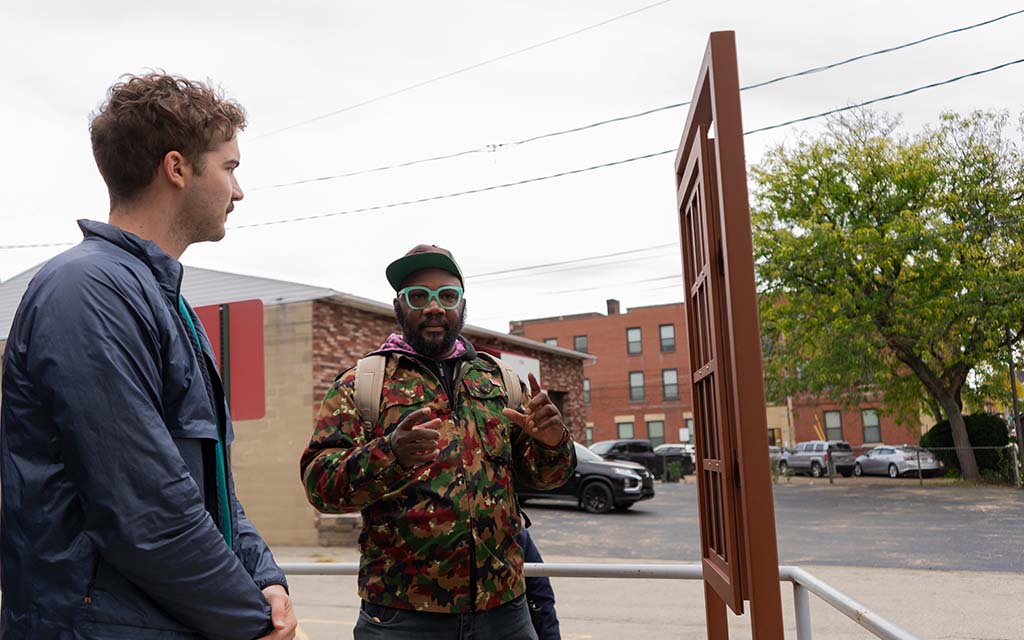
Artist Jason McKoy, right, discusses his We Are Windows installation, 2023. Photo by Ishara Henry.
Community members are highly valued collaborators with expertise in their neighborhoods.
In community development terms, we take an assets-based approach to our work. As Ives Garcia writes on the American Planning Association blog, we believe that communities have existing yet often underrecognized resources at hand—abilities, skills, and lived experiences—that can be mobilized to address the critical issues facing them. Artists are not invited to identify problems and offer solutions for the community, but rather to engage their creative practices to collaboratively catalyze these existing assets. In the process, new skills and approaches to problem solving are fostered.
While the artists engaged bring their expertise in their respective fields and practices, community members contribute their own expertise as equal partners in the collaboration. They have deep knowledge of the histories, memories, and traditions of their places, and understand what community members perceive as their greatest strengths as well as their greatest challenges. We believe that by working together, artists and communities can identify new and innovative ways to mobilize and engage the existing assets to create new futures that were previously unimaginable.
Equity and social justice are the foundation of our work.
We believe that public art’s impact is its capacity for catalyzing social change, building cohesion, and amplifying shared knowledge. To achieve these outcomes, we center equitable and just practices throughout our work—both for our public-facing programs and our internal organizational structures. This means acknowledging that, for far too long, many of our community members have been disenfranchised, overlooked, and ignored in civic processes. In particular, Black artists, Global Majority* artists, Disabled artists, and Queer and Transgender artists have been excluded from working in and shaping public space in our region. This can lead to some difficult conversations that challenge us as an organization and as individuals to recognize our missteps and mistakes, and challenge us to do better.
This work is never done. As an organization, we remain committed to listening, learning, and growing. We seek feedback from the artists, communities, and other collaborators with whom we work, and strive to share what we have learned in creating an organization that honors the multicultural realities and lived experiences of our region.
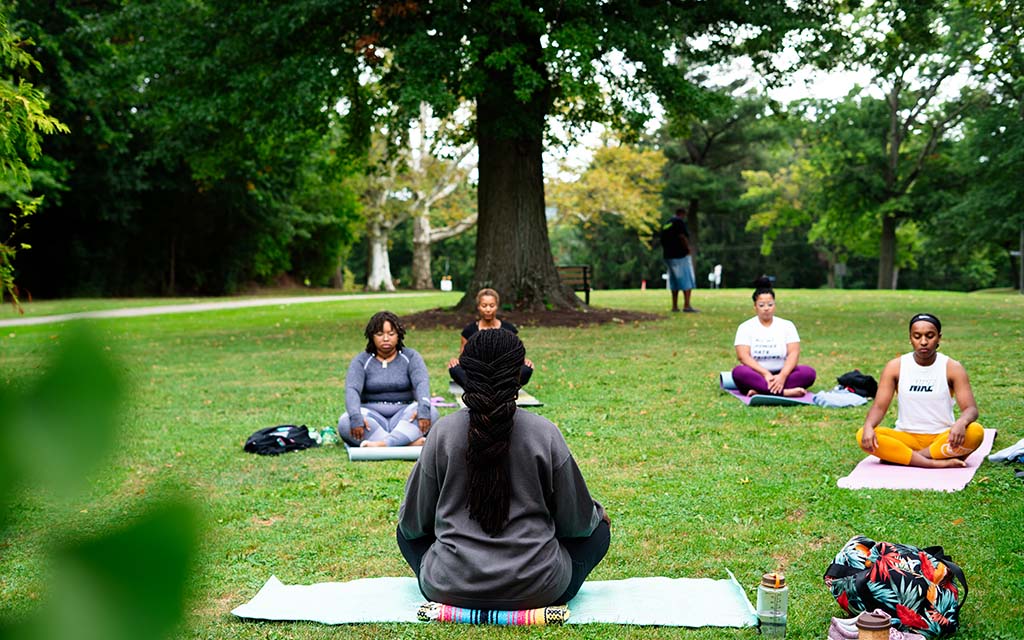
Artist Noa Mims Steel Smiling series seeks to bridge the gap between Black people and mental health support through education, advocacy and awareness. Photo by Ishara Henry, 2023.
A successful public art landscape depends upon a thriving network of public art practitioners.
In order for southwestern Pennsylvania to have resilient and flourishing communities that are engaged in creative practices, our artists, creative workers, and collaborators must also be flourishing. Shiftworks provides tools and resources for artists and others to develop their public practices, and we also advocate for investments in their work, their development, and the health of the arts community.
Shiftworks provides training and professional development for artists and others seeking to work in public space, and connects them to both local and national resources that can further their practices. We facilitate opportunities that would be out of reach for many independent artists, and guide clients and partners to provide fair compensation.
For many artists in the Pittsburgh region, a project with Shiftworks is their first professionalized public art experience. Through our processes—including artist selection, contract administration, payment procedures, and project management—we aim to build their capacity to grow their practices and expand their opportunities. Our goal is not merely having a successful public art project, but supporting the development of a public art practitioner whose practices will positively impact the region.
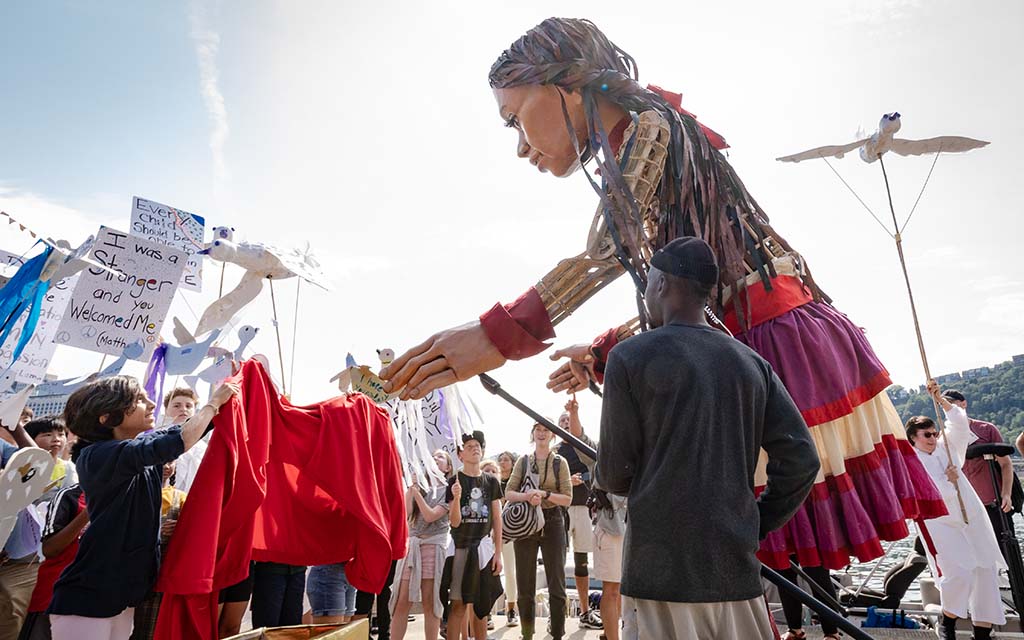
Artist Cheryl Capezutti’s Little Amal; Play in peace was an event in September 2023. Photo by Renee Rosensteel.
What’s Next: New Name, Same Mission
As a result of our 2020 strategic plan, we recognized that our original name and identity as the Office for Public Art were holding us back from telling the fullness of our story. This, in turn, hampered our ability to support others in telling their own stories.
Originally established as a partnership between the Greater Pittsburgh Arts Council and the City of Pittsburgh’s Department of City Planning, in its early days OPA provided capacity to support the City’s public art program through technical assistance and educational programming. Today, the City’s public art collection, Public Art and Civic Design Commission, and the Percent For Art program are all managed by our colleagues in the Public History, Art, and Design division at City Planning.
As a result of our original partnership, many people erroneously believed that we were part of the City of Pittsburgh rather than an independent organization that works with artists and communities across southwestern Pennsylvania. To remedy this, we engaged Pittsburgh-based design and communications firm Little Kelpie, which helped us to more clearly define who we are and tell the story of our work.
Shiftworks Community + Public Arts is not a change in mission, rather a recognition of who we are, what we do, and where we are headed. It signals a years-long shift for the organization, which has gone from a behind-the-scenes collaborator to a leading agency in our region. Shiftworks tells the story of how public art, as creative work, can shift experiences, systems, and relationships. These shifts can be sudden and require an immediate response, such as the ground-shaking changes brought about by COVID-19, which catalyzed our team to build Artists Bridging Social Distance in the early days of the pandemic. Or these shifts can be slower, resulting from the continued application of subtle but firm pressure, such as those from our continued work with municipal and other governmental agencies to include artists in their processes.
Today, Shiftworks pursues new initiatives, builds systems, and develops the resources necessary to create a sustainable and diverse ecosystem for public art for southwestern Pennsylvania. We accomplish this through delivering four key public-facing program areas: Civically Engaged Public Art, Artist Services, Public Programs, and Client Services. Each of these programs generates broader understanding and enthusiasm for engaging artists, prepares artists with the skills and tools necessary to undertake community-led projects, and actively develops partnerships and collaborations that lead to further opportunities. In addition to our own programs, we partner with artists who are leading community-engaged projects to provide administrative and planning support, providing them with the capacity to focus on being artists rather than administrators.
Throughout the next year, we will tell more stories about the artists, communities, and organizations with whom we work, sharing what we learn along the way and building more pathways for connecting our work with our region’s communities. We hope that you will join us on this journey.
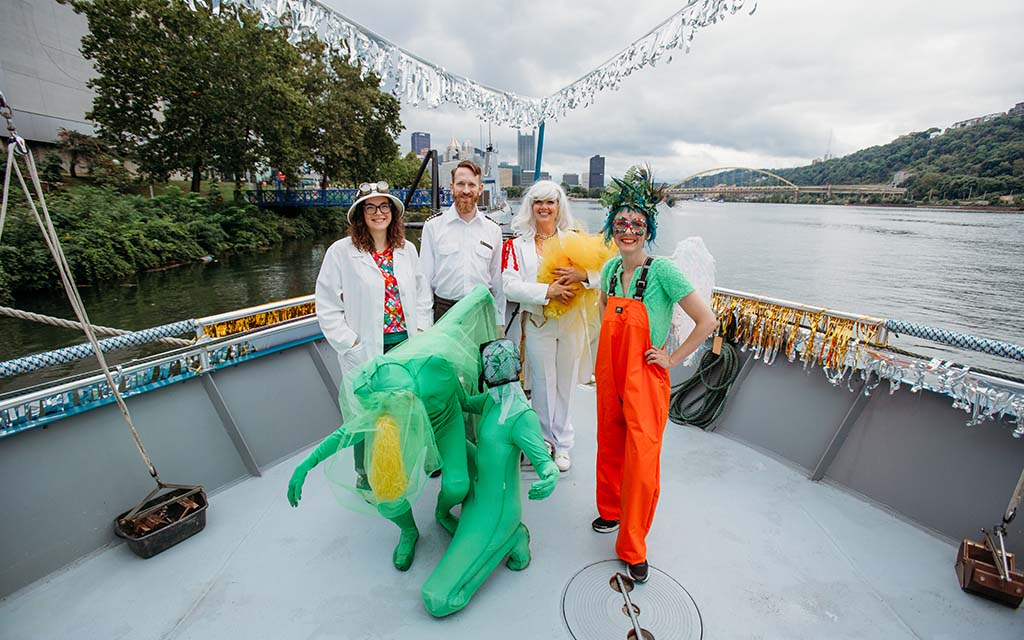
Artists Celeste Neuhaus and Heidi Wiren Bartlett presented their work Conflux on the Explorer riverboat in September 2022. Photo by Beth Barbis.
About Shiftworks
Shiftworks Community + Public Arts envisions a region in which the creative practices of artists are fully engaged to collaboratively shape the public realm and catalyze community-led change. Shiftworks builds capacity for this work through civically engaged public art, artist resources, public programming, and technical assistance.
Sallyann Kluz is a Pittsburgh-based arts administrator, architect, and urban designer whose practice is situated at the intersection of art and community development. With over 20 years of practice in the Pittsburgh region, her work is focused on the public realm and the people who inhabit it. Her practice includes public art programs and strategies, community engagement, design education, public space design, and neighborhood development strategies.
Ashley Anderson has over 10 years of experience working in customer service, hospitality, event planning, and sales, which has informed her ideas of community engagement and how to create welcoming experiences that leave a lasting impression. In her role as Marketing and Communications Manager for Shiftworks Community + Public Arts, Ashley is focused on developing strategies to effectively communicate the projects and programs of the organization. Ashley also works with artists to create marketing strategies for their individual projects.
_______________
*Shiftworks uses the term Global Majority, coined by Jamaican-British educator Rosemary Campbell-Stephens, to describe people who are Black, Asian, Brown, Latino/a/e/x, Indigenous American, dual-heritage, and people indigenous to the Global South, and/or have been racialized as ”ethnic minorities.” As Campbell-Stephens has written, “Globally, these groups currently represent approximately eighty percent (80%) of the world’s population making them the global majority.”
Shiftworks recognizes that no term used to broadly describe race or ethnicity is comprehensive or adequate. Language and the discussion around race and ethnicity are forever-evolving. As a result, Shiftworks continuously discusses the ethnic and racial terms we use as an organization.
We will continue to use specific terms that refer to race, ethnicity, or nationality as they apply to individuals and/or groups (e.g., Chinese American, Black, Chicano). Community feedback is encouraged and will be implemented into staff discussions about organizational language. To provide feedback, contact Dominique Chestand, Shiftworks operations manager, at dominique@shiftworkspgh.org.







